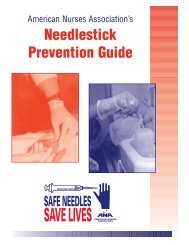Moral Courage: A Virtue in Need of Development? - American ...
Moral Courage: A Virtue in Need of Development? - American ...
Moral Courage: A Virtue in Need of Development? - American ...
You also want an ePaper? Increase the reach of your titles
YUMPU automatically turns print PDFs into web optimized ePapers that Google loves.
Ethics, Law,and PolicyVicki D. Lachman<strong>Moral</strong> <strong>Courage</strong>: A <strong>Virtue</strong> <strong>in</strong><strong>Need</strong> <strong>of</strong> <strong>Development</strong>?<strong>Moral</strong> distress has been documented s<strong>in</strong>ce 1984 byAndrew Jameton. He def<strong>in</strong>ed it as pa<strong>in</strong>ful feel<strong>in</strong>gsand/or the psychological disequilibrium that occurswhen nurses are conscious <strong>of</strong> the morally appropriateaction a situation requires, but cannot carry out theaction because <strong>of</strong> <strong>in</strong>stitutional obstacles (Corley,M<strong>in</strong>ick, Elswick, & Jacobs, 2005). This def<strong>in</strong>ition focuseson organizational obstacles to action, but there arealso personal obstacles that the nurse must conquer(for example, lack <strong>of</strong> knowledge <strong>of</strong> pr<strong>of</strong>essional obligations,lack <strong>of</strong> conflict resolution skills, etc.).This author’s <strong>in</strong>terest is not <strong>in</strong> discuss<strong>in</strong>g the existence<strong>of</strong> moral distress, but <strong>in</strong>stead how to preventand rectify the pa<strong>in</strong> and suffer<strong>in</strong>g caused by moral distress.To this purpose, this article we will focus onnecessary <strong>in</strong>gredients for moral courage. Interestedreaders can ga<strong>in</strong> additional understand<strong>in</strong>g <strong>of</strong> theproblems created when organizational culture trumpscourage by read<strong>in</strong>g the story <strong>of</strong> Enron (McLean &Elk<strong>in</strong>d, 2004). We will first def<strong>in</strong>e moral courage andthen, us<strong>in</strong>g an acronym CODE, outl<strong>in</strong>e the work fornurses who are <strong>in</strong>terested <strong>in</strong> demonstrat<strong>in</strong>g moralcourage.<strong>Moral</strong> <strong>Courage</strong> Def<strong>in</strong>edIn 350 BC, Aristotle def<strong>in</strong>ed courage as the balancebetween cowardice and rashness. He believedthat the virtue <strong>of</strong> courage must be understood as bothan end <strong>in</strong> itself and a means to a more wide-rang<strong>in</strong>ggood. He saw courage as necessary for achievement<strong>of</strong> all other virtues. He stated, “<strong>Courage</strong> is the first <strong>of</strong>human qualities because it is the quality which guar-Vicki D. Lachman, PhD, APRN, MBE, is an AssociatePr<strong>of</strong>essor, Drexel University, Philadelphia, PA.Editor’s Note: Dr. Vicki D. Lachman is the new editor <strong>of</strong> thecolumn, “Ethics, Law and Policy.” She is the author <strong>of</strong>Applied Ethics <strong>in</strong> Nurs<strong>in</strong>g (2006). This is the first <strong>of</strong> two articleson moral courage. The second article <strong>in</strong> June will focuson the application <strong>of</strong> moral courage <strong>in</strong> four cl<strong>in</strong>ical casesfamiliar to medical-surgical nurses. Dr. Lachman is open torequests for topics at vdl22@drexel.edu.antees the others.” However, Aristotle’s primary focuswas on physical courage needed <strong>in</strong> warfare, not onmoral courage.<strong>Moral</strong> courage is the <strong>in</strong>dividual’s capacity toovercome fear and stand up for his or her core values.It is the will<strong>in</strong>gness to speak out and do thatwhich is right <strong>in</strong> the face <strong>of</strong> forces that would lead aperson to act <strong>in</strong> some other way. It puts pr<strong>in</strong>ciples<strong>in</strong>to action. Physical harm could be a threat <strong>in</strong> cases<strong>of</strong> moral courage; however, the more likely risks arehumiliation, rejection, ridicule, unemployment, andloss <strong>of</strong> social stand<strong>in</strong>g. However, this personal sacrifice<strong>of</strong>ten is accompanied by a sense <strong>of</strong> peacebecause the <strong>in</strong>dividual stood up for a non-negotiablepr<strong>in</strong>ciple. <strong>Moral</strong> courage enables <strong>in</strong>dividuals toadmit to wrongdo<strong>in</strong>g and ethical dilemmas steadfastlyand self-confidently.<strong>Moral</strong> courage <strong>in</strong> the face or wrongdo<strong>in</strong>g (“rightversus wrong”) may appear <strong>in</strong>itially easier than theethical dilemmas <strong>of</strong> “right versus right.” Wrongdo<strong>in</strong>gis best understood as illegal behavior or pr<strong>of</strong>essionaland personal misconduct, such as ly<strong>in</strong>g, irresponsibility,or unfairness (Kidder, 2005). However, confront<strong>in</strong>ga physician who has deceived a patient onprognosis or confront<strong>in</strong>g a colleague who comes towork impaired by alcohol is far from easy. Whenthese core ethical issues <strong>of</strong> honesty and responsibilityare violated or disregarded, the situation islabeled “right versus wrong.”In “right versus right” situations, ethical issuesemerge when core values conflict with each other.However, ethics is not a hard science such as geometry.The pr<strong>in</strong>ciples used may blur <strong>in</strong>to one anotheralong the boundaries <strong>of</strong> the dilemma, leav<strong>in</strong>g peoplewaver<strong>in</strong>g when try<strong>in</strong>g to assert a conclusion. Thisconundrum speaks to the importance <strong>of</strong> know<strong>in</strong>gpr<strong>of</strong>essional ethical obligations and non-negotiablepersonal values.For example, <strong>in</strong> the first <strong>in</strong>stance above, thenurse has the obligation to support the physicianpatientrelationship and to support the patient’sright to <strong>in</strong>formation for <strong>in</strong>formed consent. The Code<strong>of</strong> Ethics for Nurses (<strong>American</strong> Nurses Association[ANA], 2001) addresses both <strong>of</strong> these obligations. InMEDSURG Nurs<strong>in</strong>g—April 2007—Vol. 16/No. 2 131
the second example, the nurse has the obligation“…to protect the patient, the public and the pr<strong>of</strong>essionfrom potential harm when a colleague’s practice,<strong>in</strong> any sett<strong>in</strong>g, appears to impaired” (ANA, 2001,p.15). The nurse may experience an ethical conflictbecause the organization does not address impairedpractice <strong>in</strong> a compassionate way, as the Code directs(ANA, 2001). Instead, adm<strong>in</strong>istrators fire the nurses.As can be seen by these two examples, a “right versuswrong” situation, upon further exam<strong>in</strong>ation, mayactually be a “right versus right” case.Acronym for <strong>Moral</strong> <strong>Courage</strong>An acronym <strong>of</strong>ten is helpful <strong>in</strong> remember<strong>in</strong>g thecomponents <strong>of</strong> a process. CODE will be used to suggestthe foundation necessary for moral courage (seeFigure 1). This acronym also serves as a rem<strong>in</strong>der <strong>of</strong>the pr<strong>of</strong>essional obligations <strong>of</strong> nurses, as outl<strong>in</strong>ed <strong>in</strong>the Code <strong>of</strong> Ethics for Nurses (ANA, 2001).Obligations to Honor<strong>Courage</strong> to be moral requires a def<strong>in</strong>ition <strong>of</strong> whatit means to be moral. If “moral” implies that which isgood, then moral courage also means the courage tobe ethical. Lists <strong>of</strong> ethical duties and obligations ashumans, nurses, parents, and community membersabound. How can anyone know which ones are mostimportant to honor?The Code <strong>of</strong> Ethics for Nurses (ANA, 2001) conveysthe values and obligations regulat<strong>in</strong>g the conduct<strong>of</strong> nurses <strong>in</strong> relation to their patients, colleagues,communities, and the nurs<strong>in</strong>g pr<strong>of</strong>ession.Unfortunately, this code is grossly underutilized <strong>in</strong>everyday nurs<strong>in</strong>g practice. Why? Because few nursesrecognize they are obligated to this non-negotiable,pr<strong>of</strong>essional ethical standard, simply by call<strong>in</strong>g themselvesregistered nurses. Once aware <strong>of</strong> these obligations,each nurse must f<strong>in</strong>d with<strong>in</strong> his or her own consciencethe moral courage to honor these obligations.What other guidance can be <strong>of</strong>fered to nurses?Institute for Global Ethics, through years <strong>of</strong> surveyresearch, narrowed the list <strong>of</strong> moral values to themost important five: honesty, respect, responsibility,fairness, and compassion (Kidder, 2005). These fivevalues help structure a def<strong>in</strong>ition <strong>of</strong> what is moral.Beauchamp and Childress (2002) formulated a set <strong>of</strong>pr<strong>in</strong>ciples for a common morality framework. Thisfour-pr<strong>in</strong>ciple approach consists <strong>of</strong> autonomy, beneficence,nonmaleficence, and justice. These are allfamiliar to health care pr<strong>of</strong>essionals because pr<strong>of</strong>essionalcodes <strong>in</strong>corporate them <strong>in</strong>to their rules <strong>of</strong> etiquetteand responsibilities.For example, both pr<strong>in</strong>ciplism and the Code <strong>of</strong>Ethics for Nurses (ANA, 2001) address autonomy, orthe right to self-determ<strong>in</strong>ation. The first provision <strong>of</strong>this code articulates the moral obligations <strong>of</strong> nurses<strong>in</strong> <strong>in</strong>formed consent.Patients have the moral and legal right to determ<strong>in</strong>ewhat will be done with their own persons;to be given accurate, complete, and understandable<strong>in</strong>formation <strong>in</strong> a manner that facilitates an<strong>in</strong>formed judgment; to be assisted with weigh<strong>in</strong>gbenefits, burdens, and available options <strong>in</strong> theirCODEFigure 1.Code<strong>Courage</strong> to be moral requires:Obligations to honor (What is the right th<strong>in</strong>g to do?)Danger to manage (What do I need to handle myfear?)Expression and action (What action do I need totake to ma<strong>in</strong>ta<strong>in</strong> my <strong>in</strong>tegrity?)treatment, <strong>in</strong>clud<strong>in</strong>g the choice <strong>of</strong> no treatment;to accept, refuse, or term<strong>in</strong>ate treatment withoutdeceit, undue <strong>in</strong>fluence, duress, coercion, orpenalty; and to be given necessary supportthroughout the decision-mak<strong>in</strong>g and treatmentprocess (p. 8).The code cont<strong>in</strong>ues to spell out the ethical obligation<strong>of</strong> the nurse <strong>in</strong> support<strong>in</strong>g autonomy with arem<strong>in</strong>der <strong>of</strong> the importance <strong>of</strong> capacity, culture, andthe role <strong>of</strong> surrogates. However, good moral choicesdepend on more than these values or ethical pr<strong>in</strong>ciples;these choices require the courage to act. This isa po<strong>in</strong>t Confucius made <strong>in</strong> say<strong>in</strong>g, “To see what isright, and not do it, is a want <strong>of</strong> courage or <strong>of</strong> pr<strong>in</strong>ciple.”<strong>Courage</strong> requires the management <strong>of</strong> fear.Danger to ManageWhere danger is present, there is need forcourage. In moral courage, danger is accepted for thesake <strong>of</strong> a commitment to conscience, ethics, or corevalues. This author has observed that two importantskills are necessary to tolerate the fear generated bythe perceived danger. The first is self-sooth<strong>in</strong>g, which<strong>in</strong>volves a comb<strong>in</strong>ation <strong>of</strong> relaxation and cognitiverefram<strong>in</strong>g strategies. The second skill is the ability toassess the risk <strong>in</strong>volved <strong>in</strong> stand<strong>in</strong>g up for moral convictions.First, the nurse must f<strong>in</strong>d ways to calm the <strong>in</strong>nerfear, so it does not paralyze frontal cerebral function.Fear activates the “fight or flight response” and thiscould trigger timidity or rashness. This author hasobserved that a few stand-by strategies work to calmthe physiological response, such as deep breath<strong>in</strong>g,count<strong>in</strong>g backwards from 10 slowly, and visualizationand calm<strong>in</strong>g <strong>in</strong>ner words (for example, “I amf<strong>in</strong>e. I can manage this situation”).The cognitive refram<strong>in</strong>g strategies <strong>in</strong>volve firstan awareness <strong>of</strong> the <strong>in</strong>dividual’s thoughts and then achange to thoughts that would better serve that person<strong>in</strong> solv<strong>in</strong>g the problem. It is important to rememberthat the emotion an <strong>in</strong>dividual experiencesdepends on his or her self-talk about the situation orabout the other people <strong>in</strong>volved. For example, the<strong>in</strong>dividual’s use <strong>of</strong> catastrophiz<strong>in</strong>g suggests anexpected disaster, such as be<strong>in</strong>g fired. In reality,what are the odds a physician could have a nursefired for question<strong>in</strong>g the overestimation <strong>of</strong> a prognosisfrom a certa<strong>in</strong> treatment? Because it is crucial tomanage emotions triggered by the danger, the authorsuggests several practical books that could provehelpful <strong>in</strong> manag<strong>in</strong>g emotions (Fisher & Sharp, 2004;Meyer, 2004; Sch<strong>in</strong>nerer, 2006; Thomas, 2003;Thomas & Petracek, 2004).132 MEDSURG Nurs<strong>in</strong>g—April 2007—Vol. 16/No. 2
Second, the nurse must assess the risk <strong>in</strong> stand<strong>in</strong>gup <strong>in</strong> a situation <strong>in</strong>volv<strong>in</strong>g the need for moralcourage. Risk tak<strong>in</strong>g is do<strong>in</strong>g someth<strong>in</strong>g because the<strong>in</strong>dividual believes that what is ga<strong>in</strong>ed is better thanwhat he or she has (Tulloch & Lupton, 2003). Thoughthe person is enter<strong>in</strong>g uncharted territory — theunknown, the uncerta<strong>in</strong> — he or she believes theoutcome will be worth the effort. In tak<strong>in</strong>g a risk, the<strong>in</strong>dividual learns and ga<strong>in</strong>s confidence by fac<strong>in</strong>g achallenge that will demand personal courage or faith<strong>in</strong> self or others. One <strong>of</strong> the paradoxes <strong>of</strong> life is thatgenu<strong>in</strong>e security requires risk tak<strong>in</strong>g.An <strong>in</strong>dividual may experience obligations as acerta<strong>in</strong>ty, but uncerta<strong>in</strong>ty <strong>in</strong> outcome. Therefore, thenurse also must assess the risk <strong>in</strong> the consequencesflow<strong>in</strong>g from the possible alternatives. Though allrisks <strong>in</strong>volve some ambiguity and potential for loss,tak<strong>in</strong>g action based on both rational thought and<strong>in</strong>tuition decreases the peril. Ambiguity can bereduced by obta<strong>in</strong><strong>in</strong>g more <strong>in</strong>formation and consult<strong>in</strong>gwith people who are less emotionally attached tothe outcome. Choos<strong>in</strong>g options others can supportand form<strong>in</strong>g alliances with other colleagues canreduce exposure to loss. F<strong>in</strong>ally, risks should not beconsidered without construct<strong>in</strong>g the worst case scenarioand hav<strong>in</strong>g a cont<strong>in</strong>gency plan to cope with theoutcome. Resolv<strong>in</strong>g wrench<strong>in</strong>g moral choicesrequires the will<strong>in</strong>gness to persevere <strong>in</strong> ethicalchoice, even though the journey is unknown.Expression and Action<strong>Moral</strong> courage is a means to triumph over fearthrough practical action. Know<strong>in</strong>g pr<strong>of</strong>essional obligationsand personal values is not the same as communicat<strong>in</strong>gand act<strong>in</strong>g on those obligations and values.The space between know<strong>in</strong>g and act<strong>in</strong>g is bridged bymoral courage. To quote Mart<strong>in</strong> Luther K<strong>in</strong>g, Jr., “Ourlives beg<strong>in</strong> to end the day we become silent about theth<strong>in</strong>gs that matter.”What skills are needed to express and act onobligations, as well as manage the fear? This authorhas observed that many times the expression and/oraction will run counter to the established norms <strong>of</strong>the group or organization, therefore, the <strong>in</strong>dividualwill need both assertiveness and negotiation skills.These skills are necessary for manag<strong>in</strong>g the conflictthat <strong>of</strong>ten ensues when a person dares to say or dosometh<strong>in</strong>g counter to the traditions and customs <strong>of</strong>the majority. Resources to develop these skills areprovided (Kritek, 2002; Mayer, 2006; Patterson,Grenny, McMillan, & Switzler, 2002; Urs<strong>in</strong>y, 2003).However, because conflict resolution is a skill,the more the nurse practices, the better he or shegets at resolv<strong>in</strong>g disagreements. Not only will theseactions provide experience, but they will build character;both will help the <strong>in</strong>dividual persevere <strong>in</strong> conflict.Aristotle said, “Man acquires a particular qualityby constantly act<strong>in</strong>g a particular way...we becomejust by perform<strong>in</strong>g just actions, we become temperateby perform<strong>in</strong>g temperate actions, brave by perform<strong>in</strong>gbrave actions.”Besides us<strong>in</strong>g practice to atta<strong>in</strong> moral courage,the nurse can turn to mentors to model and coach <strong>in</strong>achiev<strong>in</strong>g the skills. The <strong>in</strong>dividual can engage <strong>in</strong> dialoguewith seasoned nurses who have faced a multitude<strong>of</strong> “right versus wrong” and “right versus right”experiences. Read<strong>in</strong>g biographies <strong>of</strong> <strong>in</strong>dividuals whohave demonstrated moral courage also may be helpful.Learn<strong>in</strong>g to express and act with moral couragecan be learned from a variety <strong>of</strong> sources.ConclusionThe <strong>in</strong>dividual with moral courage knows therewards are unlike those that come from bl<strong>in</strong>d resolveor from safe harbors. He or she abides by pr<strong>in</strong>ciples <strong>in</strong>the face <strong>of</strong> danger, tak<strong>in</strong>g the time to determ<strong>in</strong>e theright th<strong>in</strong>g to do. This nurse knows his or her pr<strong>of</strong>essionalobligations and stands firm <strong>in</strong> core values thathonor patients, pr<strong>of</strong>ession, and self. The nurse hasnot acted impulsively, but has assessed the risk <strong>of</strong>action, used effective conflict resolution skills, andsought moral resolution. The nurse with moralcourage is will<strong>in</strong>g to endure the fear and act, even atpersonal cost. They agree with Amelia Earhart’s commentthat “courage is the price that Life extracts forgrant<strong>in</strong>g peace.” ■References<strong>American</strong> Nurses Association (ANA). (2001). Code for ethics for nurseswith <strong>in</strong>terpretative statements. Silver Spr<strong>in</strong>g, MD: <strong>American</strong>Nurses Publish<strong>in</strong>g.Beauchamp, T.L., & Childress, J.F. (2002). Pr<strong>in</strong>ciples <strong>of</strong> biomedicalethics (5 th ed.) New York: Oxford University Press.Corley, M.C., M<strong>in</strong>ick, P., Elswick, R.K., & Jacobs, M. (2005). Nursemoral distress and ethical work environment. Nurs<strong>in</strong>g Ethics,12(4), 282-390.Fisher, E.A., & Sharp, S.W. (2004). The art <strong>of</strong> manag<strong>in</strong>g everyday conflict:Understand<strong>in</strong>g emotions and power struggles. Westport,CT: Greenwood Publish<strong>in</strong>g Group.Kidder, R.M. (2005). <strong>Moral</strong> courage. New York: HarperColl<strong>in</strong>s Publishers.Kritek, P.B. (2002). Negotiat<strong>in</strong>g at an uneven table: Develop<strong>in</strong>g moralcourage <strong>in</strong> resolv<strong>in</strong>g our conflicts (2 nd ed.). San Francisco:Jossey-Bass.Mayer, R. (2006). How to w<strong>in</strong> any negotiation: Without rais<strong>in</strong>g yourvoice, los<strong>in</strong>g your cool, or com<strong>in</strong>g to blows. Frankl<strong>in</strong> Lakes, NJ:Career Press.McLean, B., & Elk<strong>in</strong>d, P. (2004). The smartest guys <strong>in</strong> the room: Theamaz<strong>in</strong>g rise and scandalous fall <strong>of</strong> Enron. Lewiston, NY:Portfolio Hardcover.Meyer, J. (2004). Manag<strong>in</strong>g your emotions: Instead <strong>of</strong> your emotionsmanag<strong>in</strong>g you. Massapequa Park, NY: Joyce Meyer Trade.Patterson, K., Grenny, J., McMillan, R., & Switzler, A. (2002). Crucialconversations: Tools for talk<strong>in</strong>g when stakes are high.New York:McGraw-Hill.Sch<strong>in</strong>nerer, J.L. (2006). Guide to self: The beg<strong>in</strong>ner’s guide to manag<strong>in</strong>gemotion and thought. Bloom<strong>in</strong>gton, IN: Authorhouse.Thomas, S. (2003). Healthy anger management. Knoxville, TN:University <strong>of</strong> Tennessee.Thomas, S., & Petracek, L. (2004). The anger workbook for women:How to keep your anger from underm<strong>in</strong><strong>in</strong>g your self-esteem,your emotional balance, and your relationships. Oakland, CA:New Harb<strong>in</strong>ger Publications.Tulloch, J., & Lupton, D. (2003). Risk and everyday life. London: SagePublications Ltd.Urs<strong>in</strong>y, T. (2003). Coward’s guide to conflict: Empower<strong>in</strong>g solutions forthose who would rather run than fight. New York: Sourcebooks.MEDSURG Nurs<strong>in</strong>g—April 2007—Vol. 16/No. 2 133




![National Partnership Priorities [PDF] - American Nurses Association](https://img.yumpu.com/50067378/1/190x245/national-partnership-priorities-pdf-american-nurses-association.jpg?quality=85)
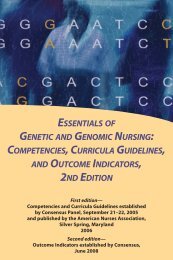
![Safety Issues Related to Tubing and Catheter Misconnections [pdf]](https://img.yumpu.com/49621668/1/190x245/safety-issues-related-to-tubing-and-catheter-misconnections-pdf.jpg?quality=85)
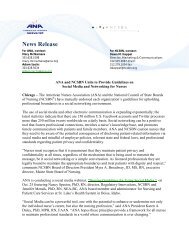
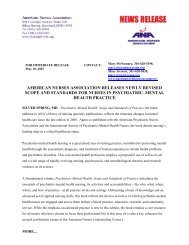
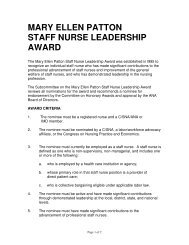
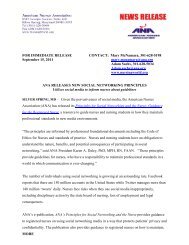
![Luther Christman Award Criteria [PDF] - American Nurses Association](https://img.yumpu.com/43348435/1/190x245/luther-christman-award-criteria-pdf-american-nurses-association.jpg?quality=85)
![JHNEBP Non-Research Evidence Appraisal [pdf]](https://img.yumpu.com/42642353/1/190x245/jhnebp-non-research-evidence-appraisal-pdf.jpg?quality=85)
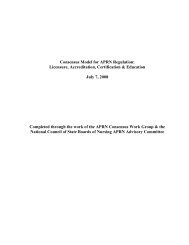
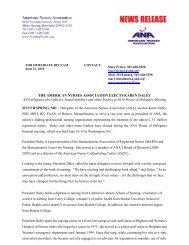
![Jessie M. Scott Award Criteria [PDF] - American Nurses Association](https://img.yumpu.com/36559235/1/190x245/jessie-m-scott-award-criteria-pdf-american-nurses-association.jpg?quality=85)
